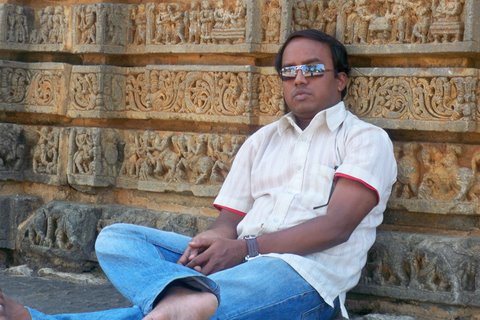Hogenakkal Falls
Hogenakkal Falls or Hogenakal Falls is a waterfall in South India on the river Kaveri. It is located in the Dharmapuri district of the southern Indian state of Tamil Nadu, about 180 km (110 mi) from Bangalore and 46 km (29 mi) from Dharmapuri town.
It is sometimes referred to as the "Niagara of India". With its fame
for medicinal baths and hide boat rides, it is a major site of tourist
attraction. Carbonatite rocks in this site are considered to be the oldest of its kind in South Asia and one of the oldest in the world.
The word Hogenakal is formed of two Kannada words hoge and kal. When the water falls on the rocks it appears as if hoge (smoke) is emanating from the top of the kal (rock) because of the force of the water, hence Hogenakkal (smoking rocks). It is also called as Marikottayam by the people of Tamil Nadu.
Kaveri River
The Kaveri is considered to form at Talakaveri in the Brahmagiri hills in the Western Ghats of south India and gathers momentum as the land drops in elevation. It becomes larger as various tributaries feed into it on the way down.
At Hogenakkal, the Kaveri, now a large river, drops and creates
numerous waterfalls as the water cuts through the rocky terrain. In
places the water falls as much as 20 m (66 ft) and is said to sound like
continual thunder. Soon after the falls the river takes a southerly course and enters the Mettur Stanley Reservoir. The river carries sediment which makes the downriver land fertile.
At Hogenakkal the river spreads out over a wide area of sandy beaches, then flows through to the Mettur Dam and creates a 60 sq mi (160 km2). lake called Stanley Reservoir. Built in 1934, this project improved irrigation and provided hydropower.
Boating in Hogenakkal
Boating in Hogenakkal is allowed during the dry-season as the water
falls are not strong enough to disrupt the passage of the boats. This is
the main source of income for these boat operators. The coracles are
about 2.24 m (7 ft 4 in) in diameter, but still can take a load of eight
persons at a time. These coracles are made of bamboo, and with all materials available takes about a day to build. The bottom of the boats are made waterproof by the use of hides, but sometimes with sheets of plastic. Use of plastics in the Hogenakkal vicinity, not just for boats, has been criticised due to problems with pollution. These boats are steered and propelled using a single paddle, making them unique. The coracles are locally called parisal in Tamil and either teppa or harigolu in Kannada.
Freshly caught fish are sold by the gorge and also various vendors
selling water and snacks up and down the gorge rowing their coracles is
not uncommon. The fish caught include katla, robu, kendai, keluthi,
valai, mirgal, aranjan and jilaby. After leaving the gorge, on the left
shore one can find improvised stalls set up on the sand. There, one can
let the fresh fishes be prepared in one of the many kitchens. Also, many
people can be found swimming or bathing around there.
The text taken from www.http://en.wikipedia.org
CA SHIVA SHANKARA R. SHETTY
CHARTERED ACCOUNTANT
Mobile: +91 9035846043 Email: ca.srshetty@icai.org
www.casrshetty228359.in

No comments:
Post a Comment